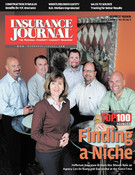I consistently hear from agencies: “Can you give me ideas to make my phone ring more often?”
This tells me right away that the agent associates sales activity with actual sales. Consider how much revenue an agency receives every time the phone rings: it actually costs an agency money. It’s only when an opportunity is converted to a sale that the agency produces any revenue.
Tracking
So how does an agency maximize sales? It all starts with tracking “source to sale.” Many agents do some form of source-to-sale tracking, but very few track the items necessary to understand their sales efficiency. In other words, many agents track where their sales are coming from, but not in relationship to what their close rate is. Think about it this way: If an agency had two sources to sale and they both generated an average of 10 policies every month, the agency probably wouldn’t prefer one over the. But what if one source resulted from 100 quotes and the other from 20 quotes? That would mean the agency has a 10 percent close rate with one soure, and a 50 percent close rate with the other. Clearly, the second is preferable.
To understand these differences, agencies not only need to track sales, but also the quotes that aren’t converted to sales. Start tracking by asking four simple questions:
- What are the agency’s primary sources of new business?
- What are the close rates for each source?
- How many policies does the agency typically sell a client that comes through each source?
- What would be the outcome of driving 100 quotes through each source?
I then ask agents to add their answers to a grid (see example). Notice the differences in actual policies sold? In this example, referrals are almost guaranteed sales opportunities with a close rate of 90 percent and typically generate two to three policies per client sold. Compare that to Internet leads, where the close rate is 5 percent and typically only one policy per sale. That means if both sources had the same 100 sales opportunities, referrals will generate 180 to 270 policies sold while Internet leads will generate only five.
This is the “WOT Factor,” which stands for Waste of Time. It’s how to define the act of quoting someone and not selling them. Is there really such a thing as a “free” quote as so many advertisements claims?
Of course, some argue that referrals are harder to get than other methods of drumming up new business. That’s true, but the point is that one only needs three quotes to produce the same amount of sales that 100 quotes would through Internet leads. Also, this means that the five policies that are sold now have to cover the cost of doing 100 quotes. Consider what it costs to quote someone and not sell them. Will those accounts ever be profitable given the real acquisition costs?
It’s not that agents should never invest in other sources of new business outside of the traditional. Rather, agents should simply make their investments in time and dollars reflect their expected return. It’s not unusual for agents to spend thousands of dollars on advertising, direct mail or Internet lead generation. But they should maximize that spending on the best sources of new business.
Maximizing an agency’s sales efficiency is an old concept. But it’s harder and harder to adhere to it for two main reasons. First, the soft market is drying up the traditional sources of new business that flowed without much marketing effort. The vast majority of agents say referrals are their best source of new business, yet they lack a plan to maximize them. Many don’t even ask for referrals on a routine basis. So when the phone starts ringing less, they look for ways to make it ring more.
There is a second reason many agents lose focus on sales efficiency is that there are so many tools out there, from direct mail lists to Web advertising and Internet lead generation. All of these are extremely accessible and appear to be very economical, but may only be efficient sources of new business to agents that fit a certain profile. Agents who want to do something differently in the soft market, should consider doing the basics better first – like maximizing their agency’s sales efficiency.
Topics Agencies
Was this article valuable?
Here are more articles you may enjoy.


 Allstate, Nationwide Post Dramatic Q12024 Homeowners Loss Ratio Drops: S&P
Allstate, Nationwide Post Dramatic Q12024 Homeowners Loss Ratio Drops: S&P  Ford Recalls 668,000 2014 F-150 Pickup Trucks Over Transmission Issue
Ford Recalls 668,000 2014 F-150 Pickup Trucks Over Transmission Issue  Zurich to Buy AIG’s Travel Insurance Business for $600 Million
Zurich to Buy AIG’s Travel Insurance Business for $600 Million  Workers Sue Disney, Say They Were Wrongly Induced to Move to Florida
Workers Sue Disney, Say They Were Wrongly Induced to Move to Florida 


